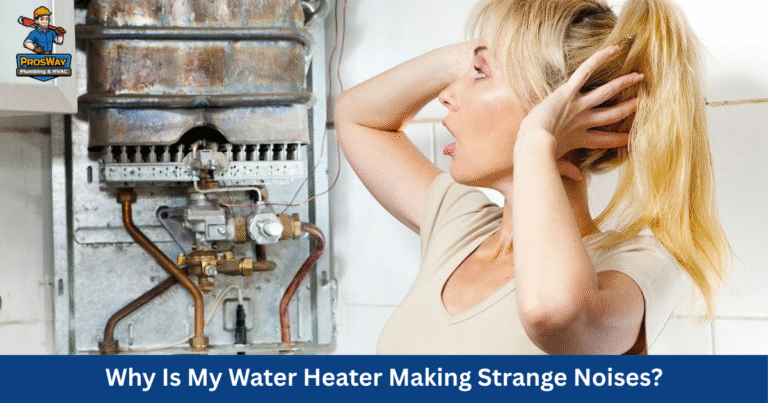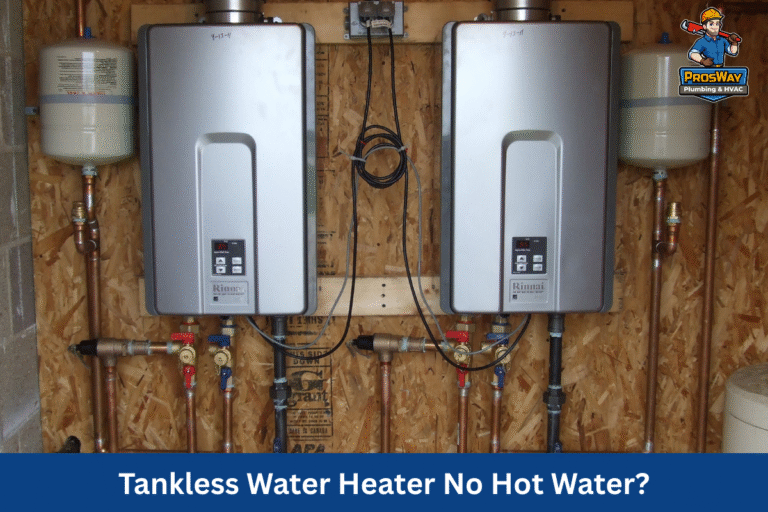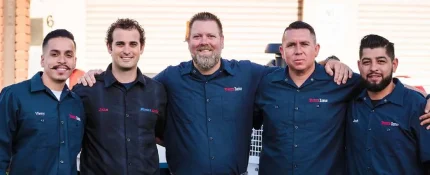A small drip from your water heater overflow pipe can be easy to overlook, but it’s one of the most important warning signs your system gives you. Known as the discharge pipe, this line connects to the temperature and pressure relief valve (T&P valve), a critical safety feature. Its job is to release water if the tank pressure or temperature climbs too high, protecting your home from far more serious risks.
So, left unchecked, it can waste energy, damage floors, or even point to dangerous pressure conditions. Today’s guide explains all about water heater overflow pipe leaking, including common causes, signs to watch for, practical steps to take, and how to prevent future issues.
Why Is My Water Heater Leaking From the Overflow Pipe?
Leaks from the overflow pipe don’t happen without reason. Here are the most common causes explained in plain terms.
Excess Pressure in Tank
When water inside the tank gets too hot or pressure rises above safe levels, the T&P valve opens and sends water down the overflow pipe. This can happen from:
- A thermostat stuck too high, overheating the water.
- Municipal supply pressure that exceeds 80 psi without a proper pressure-reducing valve (PRV).
- Thermal stress occurs when water expands in a closed plumbing system.
Faulty T&P Valve
Over time, the relief valve itself can wear out. Mineral deposits and corrosion build up around the valve seat, preventing it from closing fully. A faulty or misaligned T&P valve may drip constantly, even at safe pressure and temperature levels.
Thermal Expansion
Water expands as it heats. In closed-loop systems without an expansion tank, this extra volume pushes against the tank walls and valves. The T&P valve often becomes the pressure release point, leading to frequent discharge.
Sediment Buildup
Hard water minerals collect at the bottom of the hot water tank. This sediment creates hot spots that overheat water, leading to higher tank pressure. The result is a valve that opens more often and eventually drips continuously.
Improper Installation or Pipe Issues
Not all overflow pipes are installed correctly. An improperly routed or kinked pipe may trap water, stress fittings, or appear to leak at joints.
In some cases, loose-threaded fittings or poor sealing with Teflon tape or pipe dope cause leaks at the pipe connection rather than the valve itself.
Corrosion
As tanks and valves age, corrosion eats away at metal parts, weakening the valve threads and overflow pipe joints. This is especially common on older heaters with steel or plastic drain components. Once corrosion sets in, replacement is usually the safest fix.
Signs of an Overflow Pipe Leaking
Not every drip means disaster, but some red flags should push you to act quickly:
- Constant dripping rather than occasional spurts during heating cycles.
- Puddles near the base of the heater, showing water flow is more than minor.
- Hissing or gurgling sounds from the T&P valve or overflow pipe.
- The water heater is running more often than usual, indicating a pressure or heat imbalance.
- Noticeable spikes in utility bills or inconsistent hot water delivery.
What To Do If Your Water Heater Overflow Pipe Is Leaking?

The right first steps protect both your home and your system.
Step 1: Turn Off the Power Supply
Always start by shutting down the power. For an electric water heater, switch off the breaker at the electrical panel. For a gas water heater, rotate the gas valve knob on the control valve to the “OFF” position. This reduces the risk of electrical hazards or gas ignition while handling the unit.
Step 2: Shut Off the Cold Water Inlet
Locate the cold water inlet valve at the top of the heater and close it. This stops additional water from entering the tank, preventing further discharge from the overflow pipe.
Step 3: Inspect the T&P Valve
Examine the valve carefully. Look for corrosion, mineral deposits, or a loose threaded connection where the overflow pipe meets the valve. Sediment and mineral buildup are common in older heaters and can prevent the valve from sealing properly.
Step 4: Relieve Pressure Cautiously
Lift the small test lever on the T&P valve to let water discharge through the overflow pipe into a bucket or floor drain. This relieves excess tank pressure and helps determine if the leak is pressure-related or caused by a faulty valve.
Step 5: Check Thermostat and Pressure Settings
Excessive water temperature or pressure often causes leaks. The thermostat should be set to 120°F for safety and energy efficiency. Use a pressure gauge at an outside faucet to test municipal supply pressure.
Readings above 80 psi indicate the need for a pressure-reducing valve (PRV) on the main line. A failing or undersized expansion tank can also allow thermal expansion to push water out of the overflow pipe.
Step 6: Call a Licensed Plumber
Persistent leaks should be evaluated by professionals. A licensed technician can test the expansion tank, replace a failing T&P valve, and ensure the overflow pipe is routed correctly to a safe drain.
Prevention Checklist
A water heater overflow pipe leak can often be avoided with consistent care. Preventive steps reduce pressure fluctuations, stop sediment buildup, and extend the system’s lifespan. Here’s what homeowners should keep in mind:
- Keep thermostat at 120°F: Higher settings increase overheating risk and put unnecessary stress on the T&P valve.
- Maintain safe water pressure: Verify that household plumbing stays between 50–60 psi. Install a pressure-reducing valve (PRV) on the main supply line if readings rise above 80 psi.
- Check the expansion tank: Closed plumbing systems need an expansion tank to absorb thermal expansion. Test it annually and recharge or replace it as needed.
- Test the T&P valve once a year: Lift the lever to ensure it releases water and then reseals properly. This keeps the safety mechanism responsive.
- Flush the water heater annually: Removing sediment and mineral deposits prevents overheating and pressure spikes. Connect a hose to the drain valve and run water until clear.
- Inspect the discharge pipe: Confirm that it routes downward, free of kinks, clogs, or misalignment. The pipe should terminate at a safe floor drain.
- Schedule yearly professional maintenance: A licensed plumber can inspect valves, test pressure, and confirm compliance with local codes.
Final Thoughts
A water heater overflow pipe leak may look minor, but it’s a clear signal from your system. Sometimes it’s just doing its job, releasing excess pressure. Other times, it’s a warning of high water pressure, thermal expansion, sediment buildup, or a failing T&P valve. Ignoring it risks water damage, wasted energy, or even safety hazards. The smart move is to act early. When leaks don’t stop or the overflow pipe drips constantly, it’s time for professional service.
Stop the Leak Before It Becomes a Disaster!
Don’t wait for a drip to turn into a flood. ProsWay Plumbing & HVAC’s licensed plumbers in Northern New Jersey handle everything from T&P valve replacement to installing expansion tanks and testing pressure regulators. With local expertise and fast response times, we’ll keep your water heater safe, efficient, and code-compliant. Call us now at (862) 260-5870 or Book Online for expert water heater service and peace of mind.









